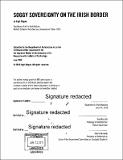Soggy sovereignty on the Irish border
Author(s)
Magee, Hugh, M. Arch. Massachusetts Institute of Technology
DownloadFull printable version (25.10Mb)
Other Contributors
Massachusetts Institute of Technology. Department of Architecture.
Advisor
Ana Miljački.
Terms of use
Metadata
Show full item recordAbstract
BREXIT caused an existential crisis in Northern Ireland, by March 2019 the Irish border, between Northern Ireland (part of the UK) and the Republic of Ireland will become the EU's only land frontier with another union. Considering more than double the number of land crossings (275) exist on the Irish border than the entire eastern block of the EU, coupled with Northern Ireland's conflicted history, how this new border should function has caused a political deadlock, and stalled UK/EU negotiations on their formal divorce. Following the 2015 migrant crisis in Europe, the BREXIT slogan "take back our borders" promoted the xenophobic vilification of a particular kind of outsider. This is particularly significant given 2016 saw a record number of visitors to Ireland in the island's history. At same moment that the idea of national sovereignty is intensifying, so too is the need for open borders. BREXIT revives the Irish border, which had all but disappeared, threatening the recovery of the region's towns, which suffered decades of militarized violence, customs checks and the general friction of the geopolitical abstraction of a border. Given this history of conflict, the UK has vowed for a "frictionless"and "invisible" border, while no proposals have been made for how this could be avoided. The only consensus between Belfast, Dublin, London and Brussels is that no "hard infrastructure" should be proposed, a non-solution based on the violent image of the Irish border's past, and wishful thinking given the administrative imperative of border management. This thesis instead argues that if construction is going to happen, it should be an architecture that takes the border town as its subject, and serves local life while attracting visitors. Indeed the majority of the border is made up of waterways that already act as anchors for an array of local and visitor activities. Having historically bore the brunt of the border's imposition; border towns have developed numerous cross community initiatives to attract EU and Tourism investment. The thesis proposes to leverage these sources of funding for grassroots community initiatives, to propose locally tuned architectural interventions along the waterways of border towns. In a context anything but stable this thesis aims to produce a space for architectural stability, bringing people together at a point of division; to float, drink and otherwise not care about the border. Soggy Sovereignty offers a space to soak in the jurisdictional ambiguity, and ultimately, challenge the Irish Border.
Description
Thesis: M. Arch., Massachusetts Institute of Technology, Department of Architecture, 2018. Cataloged from PDF version of thesis.
Date issued
2018Department
Massachusetts Institute of Technology. Department of ArchitecturePublisher
Massachusetts Institute of Technology
Keywords
Architecture.